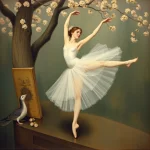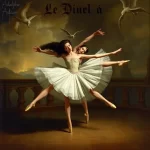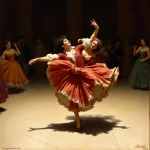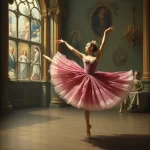Ballet: The Afternoon of a Faun (Claude Debussy, 1912)

Introduction
Ballet, as an art form, has a rich history of blending music, dance, and storytelling. One of the most iconic ballets of the early 20th century is “The Afternoon of a Faun,” choreographed by Vaslav Nijinsky with music composed by Claude Debussy. Premiering on May 29, 1912, this ballet is a one-act piece that explores themes of nature, sensuality, and mythological fantasy. The plot revolves around a faun’s dreamy afternoon encounter with nymphs, capturing a fleeting moment of desire and reverie.
Historical Background
Creation and Development
“The Afternoon of a Faun” was created during a period of significant artistic innovation and experimentation. The early 20th century saw a surge in modernist movements across various art forms, including music, dance, and visual arts. The ballet was inspired by Stéphane Mallarmé’s poem “L’après-midi d’un faune,” which itself was a reflection of the Symbolist movement, emphasizing suggestion and nuance over direct representation.
The collaboration between Nijinsky and Debussy was pivotal. Nijinsky, a principal dancer with the Ballets Russes, sought to break away from traditional ballet norms, introducing more naturalistic and expressive movements. Debussy’s composition, originally a symphonic poem, provided a lush, evocative soundscape that perfectly complemented Nijinsky’s innovative choreography. The set and costume design by Léon Bakst further enhanced the ethereal and dreamlike quality of the ballet.
Premiere and Reception
The ballet premiered on May 29, 1912, at the Théâtre du Châtelet in Paris. The initial reception was mixed, with some critics praising its boldness and others finding it scandalous due to its sensual undertones and unconventional choreography. Despite the controversy, the ballet quickly gained recognition for its artistic significance and has since become a staple in the ballet repertoire.
Notable early performances included revivals by the Ballets Russes and other prominent ballet companies. Over time, “The Afternoon of a Faun” has been reinterpreted and adapted by various choreographers, each bringing their unique vision to the timeless piece.
Synopsis of the Ballet
“The Afternoon of a Faun” is a one-act ballet that unfolds in a single, continuous scene. The narrative is simple yet profound, capturing a moment of introspection and longing.
Detailed Summary
The ballet opens with the faun lounging on a rock in a sun-drenched glade. As he awakens from his slumber, he begins to play his flute, evoking the serene and idyllic atmosphere of the forest. The faun’s movements are languid and fluid, reflecting his dreamy state.
As the faun continues to play, a group of nymphs enters the scene, frolicking and dancing gracefully. The faun is captivated by their beauty and joins them in their playful dance. The interaction between the faun and the nymphs is marked by a sense of curiosity and desire, with the faun attempting to capture the attention of one particular nymph.
The climax of the ballet occurs when the faun manages to steal a kiss from the nymph, who then flees with her companions. Left alone, the faun returns to his rock, holding a piece of the nymph’s veil. He lies down, clutching the veil to his chest, and drifts back into his dreamlike state, bringing the ballet to a poignant and contemplative conclusion.
Musical Composition
Composer’s Role
Claude Debussy, a leading figure in the Impressionist movement in music, composed the score for “The Afternoon of a Faun.” Originally written as a symphonic poem in 1894, Debussy’s composition was later adapted for the ballet. The music is characterized by its lush harmonies, fluid melodies, and evocative orchestration, which perfectly capture the ethereal and sensuous atmosphere of the narrative.
Musical Themes and Motifs
The score features several recurring themes and motifs that enhance the ballet’s narrative and emotional depth. The opening flute solo, one of the most famous passages in classical music, sets the tone for the faun’s dreamy and introspective state. Throughout the piece, Debussy employs a rich palette of orchestral colors, using instruments such as the harp, strings, and woodwinds to create a sense of movement and fluidity.
The music’s seamless transitions and subtle shifts in dynamics mirror the faun’s shifting emotions and interactions with the nymphs. The recurring motifs serve as musical leitmotifs, representing the faun’s longing and the fleeting nature of his encounter with the nymphs.
Famous Recordings and Performances
Over the years, “The Afternoon of a Faun” has been recorded by numerous orchestras and conductors, each bringing their unique interpretation to Debussy’s score. Notable recordings include those by the Berlin Philharmonic conducted by Herbert von Karajan and the Boston Symphony Orchestra conducted by Seiji Ozawa. These recordings have helped to cement the piece’s status as a masterpiece of orchestral music.
Choreography and Dance
Choreographer’s Vision
Vaslav Nijinsky’s choreography for “The Afternoon of a Faun” was groundbreaking in its departure from traditional ballet techniques. Nijinsky sought to create a more naturalistic and expressive style of movement, drawing inspiration from ancient Greek art and sculpture. His choreography emphasized angular poses, fluid transitions, and a sense of groundedness, which contrasted sharply with the ethereal and weightless quality of classical ballet.
Signature Dance Numbers
The ballet features several key dance sequences that highlight Nijinsky’s innovative choreography. The faun’s solo dance at the beginning of the ballet is a masterful display of fluidity and control, with the dancer’s movements mirroring the undulating melodies of Debussy’s score. The pas de deux between the faun and the nymph is another standout moment, characterized by its sensuality and emotional intensity.
Notable Interpretations
Over the years, “The Afternoon of a Faun” has been interpreted and adapted by various choreographers, each bringing their unique vision to the piece. Notable interpretations include those by Jerome Robbins, who created a modernist version set in a ballet studio, and Rudolf Nureyev, who brought a more classical approach to the choreography. These reinterpretations have helped to keep the ballet fresh and relevant for contemporary audiences.
Characters and Roles
Main Characters
- The Faun: The central character of the ballet, the faun is a mythical creature who embodies both innocence and sensuality. His interactions with the nymphs form the core of the narrative.
- The Nymphs: A group of ethereal beings who enter the faun’s glade and engage in a playful dance with him. One particular nymph captures the faun’s attention and becomes the object of his desire.
Supporting Characters
As a one-act ballet with a small cast, “The Afternoon of a Faun” does not feature many supporting characters. The focus remains on the faun and the nymphs, with their interactions driving the narrative forward.
Famous Dancers
Several renowned dancers have portrayed the role of the faun over the years. Vaslav Nijinsky, the original faun, set a high standard with his groundbreaking performance. Other notable dancers include Rudolf Nureyev, who brought his own unique interpretation to the role, and Mikhail Baryshnikov, whose performance was praised for its emotional depth and technical precision.
Cultural and Artistic Impact
Influence on Ballet and Dance
“The Afternoon of a Faun” has had a profound influence on the world of ballet and dance. Nijinsky’s innovative choreography challenged traditional ballet norms and paved the way for future choreographers to explore new styles and techniques. The ballet’s emphasis on naturalistic movement and emotional expression has inspired countless dancers and choreographers, contributing to the evolution of ballet as an art form.
Cultural Significance
The ballet’s impact extends beyond the world of dance. “The Afternoon of a Faun” has been referenced in literature, film, and other media, reflecting its enduring cultural significance. The ballet’s themes of nature, sensuality, and mythological fantasy continue to resonate with audiences, making it a timeless work of art.
Legacy and Revivals
Over the years, “The Afternoon of a Faun” has been revived and reinterpreted by numerous ballet companies around the world. Each revival brings a fresh perspective to the piece, ensuring its continued relevance and appeal. The ballet’s legacy is also evident in its influence on contemporary choreographers, who continue to draw inspiration from Nijinsky’s groundbreaking work.
Iconic Productions
Historic Productions
Several historic productions of “The Afternoon of a Faun” have left a lasting impact on the ballet world. The original 1912 production by the Ballets Russes, featuring Nijinsky in the title role, is perhaps the most iconic. Other notable productions include those by the Paris Opera Ballet and the Royal Ballet, each bringing their unique interpretation to the piece.
Contemporary Productions
Recent productions of “The Afternoon of a Faun” have continued to explore new interpretations and approaches to the ballet. Contemporary choreographers have experimented with different settings, styles, and themes, ensuring that the ballet remains fresh and relevant for modern audiences. These productions often incorporate innovative set and costume designs, adding new layers of meaning to the timeless narrative.
Production Design
The set, costume, and lighting design play a crucial role in bringing “The Afternoon of a Faun” to life. Léon Bakst’s original designs for the Ballets Russes were characterized by their vibrant colors and intricate details, creating a dreamlike and fantastical atmosphere. Contemporary productions have continued to experiment with different design elements, using modern technology and materials to enhance the visual impact of the ballet.
Critical Reception and Reviews
Initial Critical Response
The initial critical response to “The Afternoon of a Faun” was mixed. While some critics praised its boldness and innovation, others found it scandalous due to its sensual undertones and unconventional choreography. Despite the controversy, the ballet quickly gained recognition for its artistic significance and has since become a staple in the ballet repertoire.
Modern Reviews
Contemporary critics and audiences continue to appreciate “The Afternoon of a Faun” for its artistic innovation and emotional depth. The ballet’s timeless themes and evocative music have ensured its enduring popularity, with many considering it a masterpiece of early 20th-century ballet. Modern reviews often highlight the ballet’s influence on subsequent works and its continued relevance in the world of dance.
Fun Facts and Trivia
Behind-the-Scenes Stories
One interesting anecdote from the original production involves Nijinsky’s intense dedication to his role. It is said that he spent hours studying ancient Greek art and sculpture to perfect his movements and poses, ensuring that his performance captured the essence of the faun.
Notable Performers
Several famous dancers have left their mark on “The Afternoon of a Faun.” In addition to Nijinsky, Rudolf Nureyev and Mikhail Baryshnikov are among the notable performers who have brought their unique interpretations to the role of the faun.
Trivia
- The original title of Debussy’s composition was “Prélude à l’après-midi d’un faune,” which translates to “Prelude to the Afternoon of a Faun.”
- Nijinsky’s choreography for “The Afternoon of a Faun” was considered highly controversial at the time due to its sensual and suggestive movements.
- The ballet’s premiere in 1912 was part of a larger program by the Ballets Russes, which also included works by other prominent composers and choreographers.
Conclusion
Summary of the Ballet’s Importance
“The Afternoon of a Faun” is a significant work in the world of ballet, known for its innovative choreography, evocative music, and timeless themes. The collaboration between Nijinsky and Debussy resulted in a masterpiece that continues to inspire and captivate audiences around the world.
Final Thoughts
Reflecting on “The Afternoon of a Faun,” it is clear that the ballet’s enduring appeal lies in its ability to capture a fleeting moment of beauty and longing. The combination of Nijinsky’s groundbreaking choreography and Debussy’s lush score creates an unforgettable experience that transcends time and place. For those who have not yet experienced this iconic ballet, it is highly recommended to watch a performance or listen to the score to fully appreciate its artistic brilliance.
FAQ
What is the central theme of this ballet?
The central theme of “The Afternoon of a Faun” is the exploration of nature, sensuality, and mythological fantasy, capturing a fleeting moment of desire and reverie.
Who are the main characters in this ballet?
The main characters are the faun, a mythical creature embodying innocence and sensuality, and the nymphs, ethereal beings who engage in a playful dance with the faun.
What is the most famous dance number in this ballet?
The most famous dance number is the faun’s solo dance at the beginning of the ballet, characterized by its fluidity and control, mirroring the undulating melodies of Debussy’s score.
How long does a typical performance of this ballet last?
A typical performance of “The Afternoon of a Faun” lasts approximately 10 to 12 minutes, as it is a one-act ballet.
Are there any modern adaptations of this ballet?
Yes, there have been several modern adaptations of “The Afternoon of a Faun,” including interpretations by choreographers such as Jerome Robbins and Rudolf Nureyev, each bringing their unique vision to the piece.
Why is this ballet considered important in the history of dance?
“The Afternoon of a Faun” is considered important in the history of dance due to its innovative choreography by Vaslav Nijinsky, which challenged traditional ballet norms and paved the way for future choreographers to explore new styles and techniques. The ballet’s emphasis on naturalistic movement and emotional expression has had a lasting impact on the evolution of ballet as an art form.





